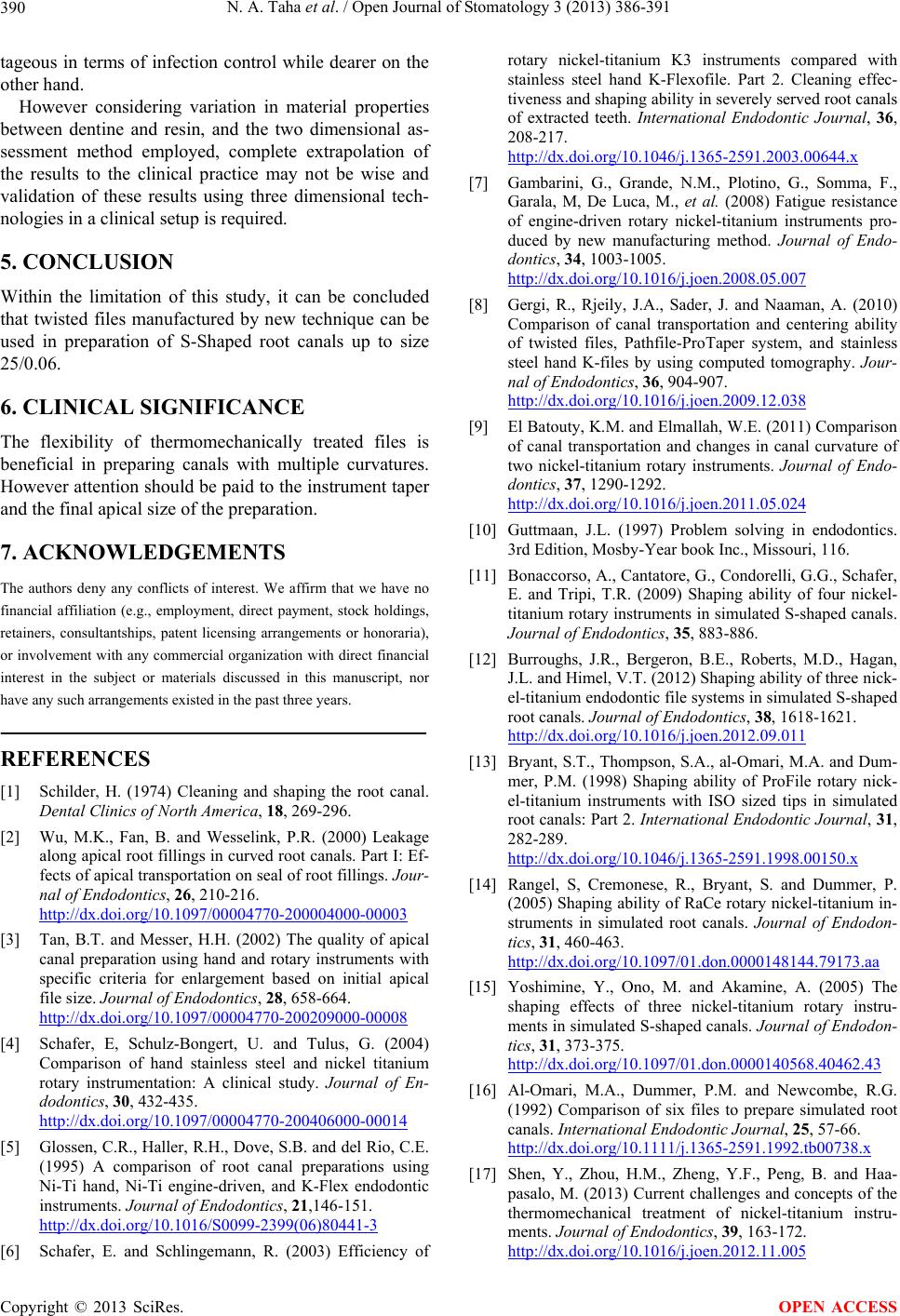
N. A. Taha et al. / Open Journal of Stomatology 3 (2013) 386-391
390
tageous in terms of infection control while dearer on the
other hand.
However considering variation in material properties
between dentine and resin, and the two dimensional as-
sessment method employed, complete extrapolation of
the results to the clinical practice may not be wise and
validation of these results using three dimensional tech-
nologies in a clinical setup is required.
5. CONCLUSION
Within the limitation of this study, it can be concluded
that twisted files manufactured by new technique can be
used in preparation of S-Shaped root canals up to size
25/0.06.
6. CLINICAL SIGNIFICANCE
The flexibility of thermomechanically treated files is
beneficial in preparing canals with multiple curvatures.
However attention should be paid to the instrument taper
and the final apical size of the preparation.
7. ACKNOWLEDGEMENTS
The authors deny any conflicts of interest. We affirm that we have no
financial affiliation (e.g., employment, direct payment, stock holdings,
retainers, consultantships, patent licensing arrangements or honoraria),
or involvement with any commercial organization with direct financial
interest in the subject or materials discussed in this manuscript, nor
have any such arrangements existed in the past three years.
REFERENCES
[1] Schilder, H. (1974) Cleaning and shaping the root canal.
Dental Clinics of North America, 18, 269-296.
[2] Wu, M.K., Fan, B. and Wesselink, P.R. (2000) Leakage
along apical root fillings in curved root canals. Part I: Ef-
fects of apical transportation on seal of root fillings. Jour-
nal of Endodontics, 26, 210-216.
http://dx.doi.org/10.1097/00004770-200004000-00003
[3] Tan, B.T. and Messer, H.H. (2002) The quality of apical
canal preparation using hand and rotary instruments with
specific criteria for enlargement based on initial apical
file size. Journal of Endodontics, 28, 658-664.
http://dx.doi.org/10.1097/00004770-200209000-00008
[4] Schafer, E, Schulz-Bongert, U. and Tulus, G. (2004)
Comparison of hand stainless steel and nickel titanium
rotary instrumentation: A clinical study. Journal of En-
dodontics, 30, 432-435.
http://dx.doi.org/10.1097/00004770-200406000-00014
[5] Glossen, C.R., Haller, R.H., Dove, S.B. and del Rio, C.E.
(1995) A comparison of root canal preparations using
Ni-Ti hand, Ni-Ti engine-driven, and K-Flex endodontic
instruments. Journal of Endodontics, 21,146-151.
http://dx.doi.org/10.1016/S0099-2399(06)80441-3
[6] Schafer, E. and Schlingemann, R. (2003) Efficiency of
rotary nickel-titanium K3 instruments compared with
stainless steel hand K-Flexofile. Part 2. Cleaning effec-
tiveness and shaping ability in severely served root canals
of extracted teeth. International Endodontic Journal, 36,
208-217.
http://dx.doi.org/10.1046/j.1365-2591.2003.00644.x
[7] Gambarini, G., Grande, N.M., Plotino, G., Somma, F.,
Garala, M, De Luca, M., et al. (2008) Fatigue resistance
of engine-driven rotary nickel-titanium instruments pro-
duced by new manufacturing method. Journal of Endo-
dontics, 34, 1003-1005.
http://dx.doi.org/10.1016/j.joen.2008.05.007
[8] Gergi, R., Rjeily, J.A., Sader, J. and Naaman, A. (2010)
Comparison of canal transportation and centering ability
of twisted files, Pathfile-ProTaper system, and stainless
steel hand K-files by using computed tomography. Jour-
nal of Endodontics, 36, 904-907.
http://dx.doi.org/10.1016/j.joen.2009.12.038
[9] El Batouty, K.M. and Elmallah, W.E. (2011) Comparison
of canal transportation and changes in canal curvature of
two nickel-titanium rotary instruments. Journal of Endo-
dontics, 37, 1290-1292.
http://dx.doi.org/10.1016/j.joen.2011.05.024
[10] Guttmaan, J.L. (1997) Problem solving in endodontics.
3rd Edition, Mosby-Year book Inc., Missouri, 116.
[11] Bonaccorso, A., Cantatore, G., Condorelli, G.G., Schafer,
E. and Tripi, T.R. (2009) Shaping ability of four nickel-
titanium rotary instruments in simulated S-shaped canals.
Journal of Endodontics, 35, 883-886.
[12] Burroughs, J.R., Bergeron, B.E., Roberts, M.D., Hagan,
J.L. and Himel, V.T. (2012) Shaping ability of three nick-
el-titanium endodontic file systems in simulated S-shaped
root canals. Journal of Endodontics, 38, 1618-1621.
http://dx.doi.org/10.1016/j.joen.2012.09.011
[13] Bryant, S.T., Thompson, S.A., al-Omari, M.A. and Dum-
mer, P.M. (1998) Shaping ability of ProFile rotary nick-
el-titanium instruments with ISO sized tips in simulated
root canals: Part 2. International Endodontic Journal, 31,
282-289.
http://dx.doi.org/10.1046/j.1365-2591.1998.00150.x
[14] Rangel, S, Cremonese, R., Bryant, S. and Dummer, P.
(2005) Shaping ability of RaCe rotary nickel-titanium in-
struments in simulated root canals. Journal of Endodon-
tics, 31, 460-463.
http://dx.doi.org/10.1097/01.don.0000148144.79173.aa
[15] Yoshimine, Y., Ono, M. and Akamine, A. (2005) The
shaping effects of three nickel-titanium rotary instru-
ments in simulated S-shaped canals. Journal of Endodon-
tics, 31, 373-375.
http://dx.doi.org/10.1097/01.don.0000140568.40462.43
[16] Al-Omari, M.A., Dummer, P.M. and Newcombe, R.G.
(1992) Comparison of six files to prepare simulated root
canals. International Endodontic Journal, 25, 57-66.
http://dx.doi.org/10.1111/j.1365-2591.1992.tb00738.x
[17] Shen, Y., Zhou, H.M., Zheng, Y.F., Peng, B. and Haa-
pasalo, M. (2013) Current challenges and concepts of the
thermomechanical treatment of nickel-titanium instru-
ments. Journal of Endodontics, 39, 163-172.
http://dx.doi.org/10.1016/j.joen.2012.11.005
Copyright © 2013 SciRes. OPEN ACCESS